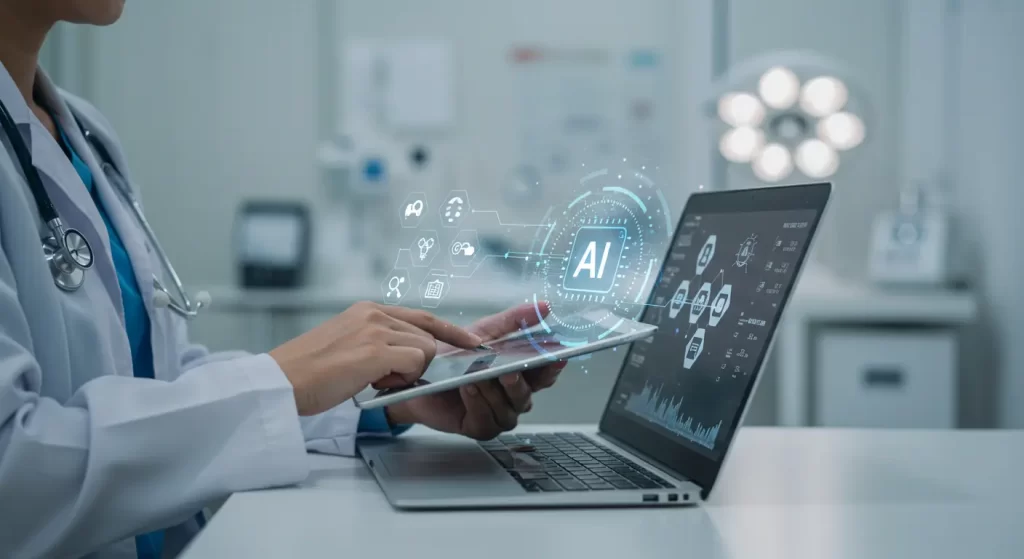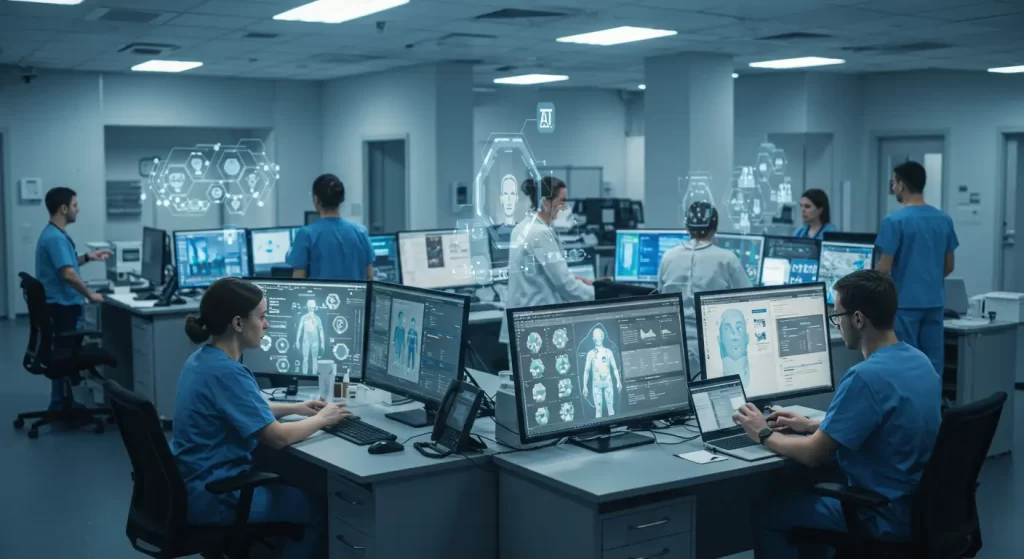The healthcare industry faces immense pressure to improve efficiency, reduce costs, and enhance patient care amidst rising demands and workforce challenges. Administrative burdens consume significant resources, potentially up to 30% of healthcare spending. In this complex environment, AI workflow automation emerges as a transformative technology. It leverages artificial intelligence to streamline, optimize, and automate tasks within healthcare workflows, enhancing operational effectiveness and patient outcomes.

Facing operational hurdles? Discover how SPsoft’s expertise in developing and integrating custom AI agents can streamline your healthcare workflows!
What is AI Workflow Automation?
AI workflow automation applies artificial intelligence technologies to perform tasks traditionally requiring human intervention, especially repetitive, time-consuming, or data-intensive ones. In healthcare, this means integrating AI into clinical and administrative processes to improve efficiency, accuracy, and decision-making. Examples include automating appointment reminders or prioritizing urgent radiology cases. The goal is to enhance productivity and allow healthcare professionals to focus on direct patient care.
Core AI technologies enabling this include:
- Machine Learning (ML). Algorithms learn from data to identify patterns and improve performance, driving predictive analytics like forecasting patient outcomes or risks.
- Natural Language Processing (NLP). Enables computers to understand and generate human language, crucial for transcribing conversations, extracting data from EHR notes, and powering chatbots.
- Robotic Process Automation (RPA). Software ‘bots’ mimic human actions for rule-based tasks like data entry. Often enhanced with AI (Intelligent Automation) to handle more complexity.
- Computer Vision (CV). Allows AI to interpret visual information like medical images (X-rays, CT scans) to aid diagnosis.
- Generative AI (GenAI). Creates new content (text, images), used for drafting clinical summaries, patient education, or synthetic data generation.
Integrating these technologies allows AI workflow automation to provide intelligent solutions beyond simple task execution.
AI vs. Traditional Automation: A Leap in Capability
Traditional automation systems follow predefined, rigid rules (“if-then” logic), effective for simple, repetitive tasks with structured data but limited in handling variability. They cannot learn or adapt without reprogramming.
AI for workflow automation is fundamentally different. It incorporates learning, adaptation, and cognitive capabilities:
- Learns from Data. Analyzes data to identify patterns, predict outcomes, and improve over time.
- Adapts in Real-Time. Adjusts workflows based on new information or changing conditions.
- Handles Complexity & Unstructured Data. Processes text, voice, images, and other complex data types.
- Makes Intelligent Decisions. Uses learned patterns for informed, context-aware decisions.
- Automates Cognitive Functions. Tackles tasks requiring understanding, judgment, and problem-solving.
Table 1. AI vs. Traditional Workflow Automation in Healthcare
| Feature | Traditional Automation | AI Workflow Automation |
|---|---|---|
| Basis | Predefined rules (If X, then Y) | Data-driven learning and adaptation |
| Adaptability | Rigid; requires manual reprogramming | Adaptive; learns and improves over time |
| Data Handling | Primarily structured data | Structured and unstructured data (text, voice, images) |
| Decision Making | Follows predefined logic | Makes intelligent, data-driven decisions; predictive |
| Task Complexity | Simple, repetitive tasks | Complex, dynamic, and cognitive tasks |
| Learning Capability | None; static rules | Learns from experience and new data |
| Example Use | Basic data entry from structured form | Analyzing EHR notes for coding; prioritizing radiology scans |
This difference enables AI for workflow automation to tackle cognitive tasks like diagnostic support or image interpretation, transforming core healthcare processes beyond simple efficiency gains. AI workflow automation represents a paradigm shift, impacting how care is delivered and decisions are made.
The Key Advantages of AI Workflow Optimization in Healthcare
Implementing AI workflow optimization yields substantial advantages, impacting efficiency, accuracy, costs, patient experience, staff well-being, and operational resilience. AI for workflow automation is reshaping healthcare delivery.
Driving Efficiency and Productivity
AI significantly boosts efficiency by automating repetitive administrative and clinical tasks like data entry, scheduling, billing, and documentation. This frees up valuable clinician and staff time (potentially reducing administrative work that consumes up to 34% of their time) to focus on patient care and complex decision-making. Results include faster claims processing, quicker scheduling, reduced report turnaround times, increased patient throughput, and more efficient resource use. Gartner predicts GenAI could cut clinical documentation time by 50% by 2027.
Enhancing Accuracy and Minimizing Errors
AI performs tasks with greater consistency than humans, reducing errors in data entry, medical coding, billing, documentation, and medication management. This leads to fewer costly claim denials, improved data reliability, and enhanced patient safety by minimizing medical errors. AI can flag inconsistencies or potential drug interactions that humans might miss.
Reducing Expenditures
Efficiency and accuracy gains translate directly to cost savings. Automating manual tasks lowers labor costs. Reducing errors cuts expenses from rework, denials, and compliance penalties. Optimized resource allocation reduces waste. AI could save the healthcare sector hundreds of billions annually. Automating just eight administrative tasks could save $13.3 billion in the US. Faster claims processing also improves cash flow.
Improving Patient Outcomes and Experience
AI workflow optimization directly contributes to better patient outcomes. Faster diagnostic processes lead to quicker treatment initiation, crucial for conditions like stroke. AI diagnostic accuracy can match or exceed human experts in areas like skin cancer detection. AI enables more personalized care plans by analyzing vast patient data. Operationally, AI reduces wait times and smooths care transitions through optimized scheduling and flow. Patient engagement improves via automated communication like chatbots and reminders.
Boosting Staff Satisfaction and Reducing Burnout
Clinician burnout, fueled by administrative burdens, is a critical issue. AI workflow optimization alleviates this by automating tedious tasks. Reducing paperwork allows staff to focus on rewarding aspects like patient interaction and complex problem-solving. This can improve morale and reduce burnout. Gartner predicts 60% of healthcare AI automation efforts by 2027 will target staff shortages and burnout.
Ensuring Scalability and Compliance
AI systems scale easily to handle increased workloads without proportional cost increases, aiding adaptability. AI also enhances compliance (e.g., HIPAA) by monitoring processes, flagging issues, and generating detailed audit trails.
The AI in healthcare market reflects this value, projected to reach hundreds of billions by the early 2030s, with CAGRs around 35-40%. These benefits are interconnected, creating a positive cycle where efficiency gains lead to cost savings and better outcomes, while reduced staff burden improves morale and care quality.
Healthcare Processes Benefiting from AI Workflow Automation
AI workflow automation applies across numerous healthcare functions, impacting both administrative and clinical operations.

Streamlining Administrative Tasks for Medical Offices
AI workflow automation tools for medical office settings significantly enhance efficiency and reduce costs by tackling repetitive tasks.
- Appointment Scheduling. AI manages online booking, sends automated reminders (reducing no-shows), handles rescheduling, and optimizes provider schedules based on availability and predicted needs. Tools like Clearstep optimize capacity.
- Patient Intake & Registration. AI-powered digital forms allow pre-visit completion, while OCR extracts data from IDs/insurance cards, reducing paperwork, wait times, and errors.
- Insurance Verification & Eligibility. AI performs real-time checks against payer databases using minimal data, confirming coverage, benefits, and co-pays in seconds. This reduces denials and saves staff time (est. 14 min/verification). Examples include Sohar Health Discovery and BillingParadise tools.
- Medical Billing and Coding. AI (using NLP) analyzes clinical notes to suggest accurate ICD-10/CPT codes, reducing errors, accelerating billing, and decreasing denials. AI can also audit claims and detect fraud. Examples include Cerner’s assistant and AKASA.
- Prior Authorization. AI automates requests by analyzing clinical data against payer rules, compiling documentation, and submitting electronically, speeding approvals and reducing care delays. Tools from CoverMyMeds and Cohere Health exemplify this.
- Revenue Cycle Management (RCM). AI optimizes the entire cycle, from registration and verification through claims, denial management, and patient payments. Cedar Pay personalizes the patient’s financial experience.
- Patient Communication. AI chatbots handle routine inquiries 24/7, answer FAQs, manage simple scheduling, and provide reminders, freeing up staff.
Enhancing Clinical Operations with AI Clinical Workflow Solutions
AI powered clinical workflow solutions directly support clinicians and improve care delivery processes.
- Clinical Documentation. AI scribes and ambient listening tech automatically transcribe patient encounters, extract relevant info, generate structured notes (e.g., SOAP), and populate EHR fields, drastically reducing documentation time and burnout. Examples: Nuance Dragon Medical One, Augmedix , DeepScribe, Abridge, Charting Hero. Gartner predicts a 50% time reduction.
- Medical Imaging Analysis. AI (using CV/DL) analyzes scans (CT, MRI, X-ray, pathology) to detect abnormalities (cancer, stroke), prioritize urgent cases, assist interpretation, and improve consistency. Examples: Aidoc, Enlitic , Viz.ai, Philips/Ibex.
- Clinical Decision Support (CDS). AI integrates with EHRs to provide real-time, evidence-based support, analyzing patient data to offer diagnostic suggestions, treatment recommendations, drug interaction alerts, and risk predictions (e.g., sepsis). Examples: Merative (Micromedex), Regard, Pieces.
- Triage and Prioritization. In EDs or for urgent conditions, AI rapidly analyzes data to assess urgency and prioritize cases, optimizing flow and ensuring timely care. Aidoc’s stroke tools are an example.
- Resource Allocation & Management. AI predicts patient volumes and demand, optimizing staff schedules and allocation of beds/equipment for better efficiency and reduced bottlenecks. Clearstep focuses on capacity management.
- Medication Safety & Management. AI analyzes records to identify potential adverse drug events, check interactions, suggest alternatives, and ensure dosing accuracy. Merative’s Micromedex offers AI-enhanced support.
- Drug Discovery & Development. AI accelerates research by identifying candidates, predicting efficacy, and optimizing clinical trials. Gartner expects GenAI to discover >30% of new drugs/materials by 2025.
Table 2. Key Healthcare Applications & Benefits of AI Workflow Automation
| Process Area | Specific Task | How AI Automates / Optimizes | Key Benefits |
|---|---|---|---|
| Administrative | Appointment Scheduling | Automates booking, reminders, optimizes schedules | Reduced no-shows, efficiency, better resource use, patient satisfaction |
| Administrative | Insurance Verification | Real-time eligibility/benefits checks via payer connections | Reduced denials, faster RCM, less admin work, improved accuracy |
| Administrative | Medical Billing & Coding | Analyzes notes (NLP) for codes, detects errors/fraud | Increased accuracy, reduced denials, faster billing, compliance |
| Administrative | Prior Authorization | Automates request generation based on clinical data & rules | Faster approvals, reduced care delays, less admin burden |
| Clinical | Clinical Documentation | Transcribes encounters (NLP/ambient AI), generates notes | Reduced clinician burden/burnout, more patient focus, improved accuracy |
| Clinical | Medical Imaging Analysis | Detects abnormalities (CV/DL), prioritizes cases | Faster diagnosis, improved accuracy, higher throughput, decision support |
| Clinical | Clinical Decision Support | Analyzes patient data (ML), provides alerts & recommendations | Improved decision quality, enhanced safety, personalized care |
| Clinical | Triage & Prioritization | Assesses urgency based on data, optimizes patient flow | Faster care for critical cases, reduced wait times, efficient resource use |
AI workflow automation often blurs the lines between administrative and clinical functions, fostering integrated optimization. For example, AI coding tools need clinical understanding, while CDS impacts resource use. This holistic approach drives greater overall efficiency.
Exploring AI Workflow Automation Tools for Healthcare
Understanding the technologies and specific tools available helps clarify the landscape of AI workflow automation.
Types of AI Technologies Powering Automation
Key technologies include:
- Robotic Process Automation (RPA). Bots mimic human actions for rule-based tasks; enhanced by AI (IPA) for more complex scenarios.
- Natural Language Processing (NLP). Enables computers to process and understand human language for transcription, data extraction, chatbots.
- Machine Learning (ML). Algorithms learn from data for prediction, risk stratification, diagnostic aid, personalization. Deep Learning (DL) handles complex patterns like images.
- Computer Vision (CV). AI ‘sees’ and interprets images (radiology, pathology).
- AI Chatbots / Virtual Assistants. Conversational AI for FAQs, scheduling, reminders.
- Generative AI (GenAI). Creates new content (text, images, code) for documentation summaries, patient materials, synthetic data, drug discovery.
Examples of AI Workflow Automation Tools for Clinical Settings
Numerous tools leverage these technologies:
- RPA & Intelligent Automation. UiPath, Automation Anywhere, Microsoft Power Automate.
- Clinical Documentation & AI Scribes. Nuance Dragon Medical One, Augmedix , DeepScribe, Abridge , Charting Hero.
- Medical Imaging AI. Aidoc , Enlitic , Viz.ai, Philips/Ibex , AIRSMed.
- Billing, Coding & RCM AI. Cerner/Oracle Health, Epic Systems, AKASA , Cedar Pay , BillingParadise AI.
- Scheduling, Intake & Verification AI. Clearstep , Sohar Health Discovery , formsflow.ai.
- Clinical Decision Support (CDS). Merative (IBM Watson Health), Regard, Pieces, Arrow.
- Prior Authorization Automation. CoverMyMeds, Cohere Health.
- General AI Platforms. Google (Med-Gemini) , OpenAI (ChatGPT), Microsoft Copilot, Anthropic Claude (used within secure environments).
The landscape includes specialized niche tools and general platforms. Effectively leveraging AI powered clinical workflow solutions requires strategic selection, integration (especially with EHRs), and management.
Measuring Success: KPIs for AI Workflow Optimization
Rigorous measurement is crucial to demonstrate the value of AI workflow optimization investments. Success involves quantitative (financial, operational) and qualitative (patient, staff experience) metrics. Link use cases to specific Key Performance Indicators (KPIs) upfront. Productivity is often key.
Table 3. Key Performance Indicators (KPIs) for Measuring AI Workflow Success
| KPI Category | Specific KPI | How AI Impacts It | Example Measurement |
|---|---|---|---|
| Financial | Return on Investment (ROI) | Compares financial gains to AI investment cost | ((Net Benefits – Total Costs) / Total Costs) * 100% |
| Cost Reduction | Automates tasks, reduces errors, optimizes resources | % decrease in cost per claim processed | |
| Operational | Processing Time Reduction | Automates steps, speeds up analysis/decision-making | % reduction in time for insurance verification |
| Patient Throughput Rate | Optimizes scheduling, accelerates diagnosis/treatment | Increase in patients seen per session | |
| Quality/Accuracy | Error Rate Reduction | AI consistency minimizes human mistakes | % decrease in claim denial rate due to coding errors |
| Diagnostic Accuracy Rate | AI algorithms analyze data (e.g., images) for detection | % agreement with expert diagnosis | |
| Patient Exp. | Patient Satisfaction (CSAT/NPS) | Reduced wait times, faster results, improved communication | Increase in patient survey scores |
| Time to Diagnosis | AI speeds up analysis and decision support | Reduction in days/hours from visit to diagnosis | |
| Staff Exp. | Staff Satisfaction | Reduces administrative burden, allows focus on care | Improvement in staff satisfaction survey scores |
| Tool Adoption Rate | Measures how well staff integrate AI into workflows | % of target users actively using the tool weekly/monthly |
Evaluating AI workflow optimization requires a holistic view beyond just IT metrics or simple ROI. Clinical quality, patient experience, and especially staff experience (adoption, satisfaction, time saved, burnout) are critical. Poor staff adoption undermines the entire investment, making staff-centric KPIs essential leading indicators of success.
Implementing AI Workflow Automation: Practical Considerations
Successful implementation of AI for workflow automation requires careful planning and management of technical, data, security, compliance, and human factors.

Staff Training and Change Management
Managing the human element is paramount.
The Challenge: Resistance stems from fear of job displacement, loss of autonomy, mistrust of “black box” AI, concerns about bias, or frustration with poorly integrated/designed tools. Healthcare’s cautious culture can also be a barrier.
Best Practices:
- Comprehensive Training. Provide role-specific training on AI fundamentals, tool functions, benefits, and limitations. Use hands-on methods and offer ongoing support.
- Clear Vision Communication. Leadership must articulate AI’s purpose as augmenting staff and improving care, ensuring transparency.
- Early Staff Involvement. Engage end-users in needs assessment, tool selection, and workflow design. Solicit continuous feedback.
- Leverage Change Champions. Empower enthusiastic early adopters to advocate, support peers, and address skepticism.
- Phased Implementation. Start with pilot projects demonstrating quick wins to build trust and momentum.
- Prioritize User Experience (UX) & Integration. Choose intuitive tools that integrate seamlessly with existing workflows (especially EHRs) to minimize disruption.
Integration and Technical Aspects
Integrating AI into complex IT ecosystems is challenging.
The Challenge: Healthcare IT involves mixed legacy and modern systems (EHRs, PACS, billing). Integration is hindered by proprietary interfaces, lack of standardization, and technical limitations. Data is often siloed, incomplete, unstructured, or lacks quality.
Best Practices:
- Thorough Needs Assessment. Map existing workflows, identify bottlenecks, and define automation goals before selecting tools.
- Select Appropriate Tools. Choose solutions based on specific needs, integration capabilities (APIs, standards like FHIR), scalability, and security.
- Prioritize Data Quality & Governance. Invest in data cleansing, standardization, and ongoing management. Ensure AI has access to reliable data.
- Plan for Interoperability. Develop a strategy for data exchange using integration engines, standards (FHIR), or vendor collaboration.
Security and Compliance (HIPAA)
Handling Protected Health Information (PHI) requires strict adherence to regulations like HIPAA. AI adds complexity.
The Challenge: AI processes vast PHI, increasing breach risks. Ensuring privacy/security throughout the AI lifecycle (training, processing, vendor management) is critical. AI bias can lead to discrimination and compliance issues. “Black box” AI hinders auditing.
Best Practices:
- Compliance-by-Design. Integrate HIPAA (Privacy, Security, Breach Rules), HITECH, FDA guidelines etc., from the start.
- Robust Technical Safeguards. Use encryption, strict access controls (RBAC, MFA), audit logs, monitoring, intrusion detection, patching. Use HIPAA-compliant hosting.
- Data Minimization & De-identification. Use only necessary PHI. De-identify/anonymize data for training where possible (Safe Harbor/Expert Determination). Ensure vendors don’t misuse data.
- Vendor Due Diligence & BAAs. Vet third-party AI vendors for HIPAA compliance and security. Ensure robust Business Associate Agreements (BAAs) are in place.
- Regular AI-Specific Risk Assessments. Conduct periodic risk assessments focused on AI vulnerabilities. Document and mitigate risks.
- Ethical AI Guidelines & Bias Mitigation. Develop policies for ethical AI use. Actively identify and mitigate bias in data/algorithms. Promote transparency (XAI)..
- AI-Specific Incident Response Plans. Update plans for AI-related breaches or failures.
- Maintain Human Oversight. Ensure critical clinical decisions involve human review and validation.
Ensuring compliance is vital. Resources like the HHS Security Rule Guidance or guides from the HIPAA Journal offer details. Implementing AI workflow automation is an ongoing journey requiring continuous adaptation, governance, monitoring (performance, security, bias), model validation/retraining, staff training, and process refinement.
The Future of AI Workflow Automation in Healthcare
AI workflow automation is evolving rapidly. Future trends suggest AI will become more integrated, intelligent, and proactive.
Key trends include:
- Generative AI Expansion. Impacting personalized communication, synthetic data generation, drug discovery, and tailored education.
- Rise of Agentic AI. More autonomous AI systems managing multi-step workflows and proactively resolving issues.
- Multimodal AI. Processing and synthesizing insights from text, images, voice, and sensor data simultaneously.
- Hyperautomation. Converging AI, RPA, and other tech for large-scale, end-to-end process automation.
- Enhanced Personalization. Driving more tailored treatment plans, risk predictions, and patient engagement strategies.
- Focus on Explainability and Trust (XAI). Increasing demand for transparent AI models to foster trust.
- Private and Secure AI Models. Growing interest in models run within secure organizational environments.
Gartner predicts increased data collection fueling AI and trends like GenAI profoundly reshaping healthcare. These trends point towards AI becoming a pervasive intelligence layer within core systems like EHRs, acting as co-pilots across workflows. Realizing this requires tech progress, data integration, infrastructure readiness, and robust governance frameworks.
Final Thoughts
AI workflow automation is pivotal for healthcare, offering powerful tools to address efficiency, cost, accuracy, and workforce challenges. By automating administrative tasks and augmenting clinical decisions, AI for workflow automation frees up resources for patient-centered care.
The benefits, such as increased speed, reduced errors, cost savings, enhanced outcomes and experiences, improved staff satisfaction, are substantial. Applications range from AI workflow automation tools for medical office tasks like intake and billing, to AI powered clinical workflow solutions for diagnostics and documentation.
However, success requires strategic planning, integration management, data governance, security/compliance diligence, and effective change management with staff training. As AI evolves, its role will become even more integral. Embracing workflow automation responsibly is key to a more sustainable, efficient, and human-centric healthcare future.
Ready to leverage AI workflow automation in your medical organization? Our deep expertise in healthcare AI ensures seamless development and integration of solutions tailored to your unique needs!
FAQ
How can AI optimize clinical and administrative workflows in healthcare?
AI optimizes workflows by automating repetitive tasks (scheduling, intake, billing, coding) and enhancing clinical processes (documentation via AI scribes, faster image analysis, CDS, triage). This AI workflow optimization increases efficiency, accuracy, reduces costs, improves outcomes, and lessens staff burnout.
What’s the difference between AI and traditional workflow automation tools?
Traditional tools follow fixed rules, suitable for simple, structured tasks, but lack learning and adaptation. AI automation is data-driven, uses ML to learn, adapt, handle complex/unstructured data (text, images), and make intelligent decisions, automating cognitive tasks.
Which healthcare processes benefit most from AI-driven optimization?
High-volume administrative tasks (billing, scheduling, prior auth), data-intensive clinical tasks (image analysis, documentation), error-prone processes (coding, medication safety), time-sensitive processes (stroke diagnosis, ED triage), and resource optimization (patient flow, staffing) benefit significantly from AI workflow optimization.
Can AI automate tasks like appointment scheduling or billing?
Yes, these are common applications. AI systems manage scheduling (booking, reminders, optimization) and billing (analyzing notes for codes, preparing claims, checking errors). These AI workflow automation tools for medical office settings are highly effective.
How does AI improve patient intake and insurance verification workflows?
AI enables digital intake forms (reducing errors, paperwork) and uses OCR to extract data. For insurance verification, AI performs real-time eligibility checks via payer databases using minimal data, confirming coverage quickly and accurately. This reduces denials, speeds RCM, and improves patient financial clarity.
What KPIs can be used to measure workflow improvement from AI?
Use a balanced set of KPIs:
– Financial. ROI, cost savings, reduced denial rates.
– Operational. Reduced processing time, increased throughput, uptime, automation rate.
– Quality/Accuracy. Reduced error rates, improved diagnostic accuracy, data quality.
– Patient Experience. Satisfaction scores (NPS, CSAT), reduced wait times, faster time-to-diagnosis.
– Staff Experience. Satisfaction/morale, reduced burnout/turnover, tool adoption rates, time saved.
Is it hard to train staff to use AI-based workflow tools?
Difficulty varies based on tool complexity, UI intuitiveness, training quality, and change management effectiveness. Success requires comprehensive, role-specific training, clear communication of benefits, staff involvement, user-friendly tools, and ongoing support.
Is AI safe and compliant for automating sensitive healthcare workflows?
AI can be safe and compliant, but requires rigorous planning and diligence. This involves:
– Robust security (encryption, access controls, audits)
– Strict HIPAA adherence (vendor vetting, BAAs)
– Strong data privacy (minimization, de-identification)
– Active bias monitoring/mitigation, model validation, and human oversight for decisions
– Safety and compliance are ongoing responsibilities.



